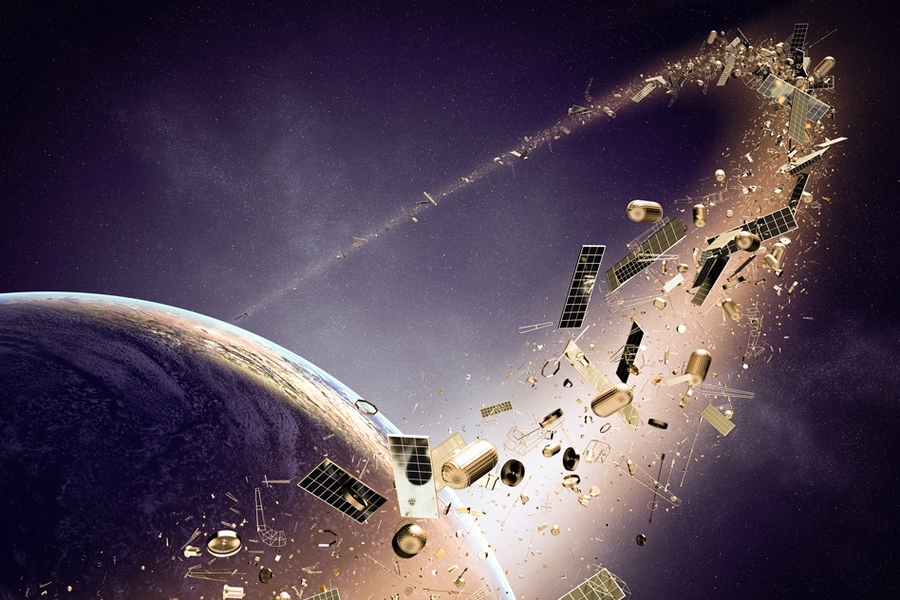Following in the footsteps of China, Russia is now working on a maneuverable vehicle that can deorbit space debris. The project is at the stage of its development. These should be maneuverable space vehicles making it possible to deorbit large space junk objects,” Vadim Khromov, Deputy CEO, Corporate Development and Investment, Tactical Missiles Corporation of Russia, told Tass.
Chinese ‘Stealth’ Espionage! How Beijing-Backed Hackers ‘Acquired’ Sensitive US Tech Used In Its F-35 Fighter Jet?
He stated that future maneuverable vehicles will be engineered to drop space junk from orbit so that it burns up in the atmosphere or falls safely on Earth. The project is under development; the company has not announced any deadlines for its testing or production.

Previously, a Russian startup announced its plan in 2020 to create a “Foam Debris Catcher” satellite, which would spray polymeric foam on space debris that will then sink safely and burn up in the Earth’s atmosphere.
However, there has been no further progress on the project since then. Last year, the company merged its many projects with another Russian start-up.
China Leading The Race?
Recently, a Chinese satellite SJ-21 pulled a dead satellite from its normal geosynchronous orbit to a graveyard orbit a few hundred miles away, EurAsian Times reported. The revelation caused quite a stir among space experts.
Graveyard orbits are designed for defunct satellites that are approaching the end of their service life, with the goal of reducing the chance of impact with functioning assets.
This unusual maneuver was noticed by Exoanalytic Solutions, a commercial space monitoring firm. During a webinar hosted by the Center for Strategic and International Studies (CSIS), Brien Flewelling of Exoanalytic Solutions claimed the Chinese satellite Shijian-21 or SJ-21 “appears to be functioning as a space tug”.
Shijian-21 was sent into geosynchronous transfer orbit in October 2021 by a Long March 3B rocket. The spacecraft is categorized as an OSAM satellite (On-Orbit Servicing, Assembly, and Manufacturing). OSAM is a wider concept of assets designed to approach and interact with other satellites.
The launch, on the other hand, came after the Shanghai Academy of Spaceflight Technology demonstrated a mockup of a servicing satellite, called a space fuel tanker, at an airshow in September. The model of the spaceship had robotic arms that could be used to connect to another satellite.
SJ-21 will “test and verify space debris mitigation technologies,” according to Chinese state media, but no other details have been revealed.
Dual-Use Technology?
Speculation about the satellite began to circulate in November 2021 after an unidentified object was discovered orbiting alongside SJ-21. The US Space Force initially categorized it as a spent apogee kick motor, but later said that it could have been an experimental payload designed to test SJ-21’s ability to undertake remote operations.
The SJ-21’s movement raises questions regarding the potential military application of such satellites. The Pentagon is deeply concerned about China’s expanding space technology.
According to US Space Command chief James Dickinson, who raised the subject before the US Congress last year, spacecraft like SJ-21 and others “could be used in a future system for grabbing other satellites”.
In 2013, apprehension was raised that Chinese satellites were using robotic arms to catch other spacecraft. A robotic arm launched onboard China’s Tiangong space station’s Tianhe module displayed similar capabilities.
A report released by the US Air Force’s China Aerospace Studies Institute (CASI) in December 2021 claimed that Shijian-21 satellite could have military as well as research or utility functions. It also says that “even Chinese media, academics, and bloggers agree with Western analysts that remote proximity operation capabilities and robotic arm technologies are dual-use.”
SJ-21 was also rumored to have some type of net for catching space debris, which was mentioned in the article. However, the potential uses of dual-use satellites are difficult to estimate.
CASI stresses that, while SJ-21 previous acts show technology that may permit weapons or reconnaissance capabilities, they are consistent with China’s peaceful economic and scientific goals in space, particularly in terms of debris clearance.
Meanwhile, OSAM capabilities are not limited to China; European and American corporations have already devised similar technology. Mission Extension Vehicles (MEV-1 and MEV-2) were successfully launched by Northrop Grumman Space Logistics. A film of their rendezvous with target satellites was also released.
Now that Russia has entered into the race, it will undoubtedly raise additional concerns among US forces, as these technologies are thought to be capable of being used against hostile satellites and knocking them off their orbits.
- Contact the author at ashishmichel@gmail.com
- Follow EurAsian Times on Google News